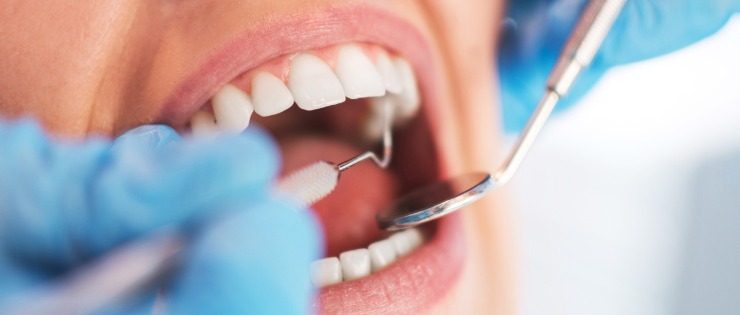
A visit to the dentist is one of those appointments many of us put off. We know we should go to the dentist, we only get one set of adult teeth after all. But often life gets in the way, and we can’t remember the last time we had a dental check-up.
Some people assume that if they aren’t experiencing any tooth pain, they don’t have a dental problem. But not all dental problems are painful.
How Often You Should Visit the Dentist
It’s recommended that all Australians visit a dentist every six months. This time period allows a dentist to detect any sign of cavities, gum disease and oral cancer in their early stages.
By going to the dentist, you can be informed of any problems that lie below the gum line and other hidden areas of the mouth that you can’t see. Most problems can then be treated before any irreparable damage occurs.
How often you should attend the dentist may also depend on your risk factors. Some people may see a dentist more often than six monthly if they are at greater risk of dental or health problems such as:
Diabetes
Pregnancy
Gum disease
Smoking
Dry mouth (often caused by some medications)
Weak immune response to bacterial infections
Recent missing tooth
Prone to cavities or plaque build-up

Will I Need X-Rays at the Dentist?
X-rays are usually taken every two years. An x-ray can reveal tissue, teeth and bone that can’t otherwise be seen by the dentist through a visual check. A dentist checks patient x-rays for signs of cavities below the gum line or in between teeth, hidden wisdom teeth, impacted teeth that may be rubbing against each other, teeth missing in gums, jaw placement and bone loss, problems with the jaw joint and facial bone composition.
Dental Problems and the Link to Health Problems
A check-up, clean and scale at the dentist every six months can reduce the risk of several dental problems.
Removing Plaque Build-up
You might be diligent at brushing and flossing your teeth morning and night, but plaque can still collect on teeth, especially those difficult to reach areas. A professional scale and clean removes any tartar and plaque which you may or may not be able to see. By removing tartar and plaque, you’re less likely to suffer tooth decay. No one likes having a tooth drilled and filled in so you could be saving yourself another trip to the dentist.

Removal of Light Stains
A professional clean, scale and polish can remove some light stains on teeth that occur from eating and drinking some foods. Red wine, tea, coffee, curries, soy sauce, cola soft drinks, and tomato-based sauces can all contribute to the discolouration of our teeth. Having your teeth cleaned can make your teeth appear slightly whiter and brighter.
Treat Gum Disease Before it Progresses
A visit to the dentist is important for checking for signs of gum disease. Around 3 in 10 Australian adults have moderate to severe gum disease. Risk of gum disease increases with age. Between the ages of 15-24 years, only 2.7% of people suffer from gum disease but by the age of 65, the risk increases to more than 53%.
Symptoms of gum disease include:
Red, swollen gums
Bleeding while brushing
Receding gums
Bad breath
Loose teeth
Dentures that don’t fit
Changes in bite and jaw

The two forms of gum disease are gingivitis and periodontal disease. If you notice your gums are red and swollen and often bleed when brushing, it’s likely you have gingivitis. A dentist can treat gingivitis by cleaning off the plaque and tartar and showing patients how to brush and floss to keep their teeth free of plaque.
Untreated gingivitis can progress to periodontal disease which can’t be cured, only treated to keep it under control. Pockets form between teeth and gums which can lead to receding gums and loose teeth which are at risk of falling out. Fallen teeth can cause jaw bone loss which can change the structure of the face. Some people with periodontal disease benefit from having the dentist clean their roots below the gum line to remove any bacteria. Antibiotics may be needed for the pockets around teeth to stop the progression of the disease.
Some people with advanced periodontal disease may be recommended to have surgery to clean the infected areas under the gums, reshape or replace tissue, reduce the size of the pockets, graft soft tissue and lengthen crowns.
Examine Teeth and Mouth for other Dental Problems
During a dental examination, your dentist is checking your mouth for signs of oral health concerns. A large number of adults grind or clench their teeth during their sleep. Signs of wear on the teeth may indicate the need for a night guard to protect the teeth from further damage.
A dentist may notice an abscess or infection in the gum or mouth that needs further treatment. Oral cancer may also be noticed by a dentist during an examination.
Research has revealed links between dental issues and serious health problems. Regular dental examinations and cleans may help prevent the following conditions:
Coronary Heart Disease
Untreated gum disease has been found to contribute to coronary heart disease, the most common cause of death in Australian adults. While the plaque on your teeth isn’t the same as the plaque in your heart valves that causes coronary heart disease, there is a link between gum disease and heart disease. Periodontal disease increases inflammation in the body which contributes to atherosclerosis, the fatty plaque that builds up on the inside of arteries. People with periodontal disease have two to three times the risk of having a heart attack.

Diabetes
When diabetes isn’t controlled well, it causes higher blood sugar levels in saliva which promotes bacteria that can cause gum disease. Diabetes also causes gum disease because blood vessels thicken and reduce the flow of nutrients and waste removal from the body’s tissues. This reduced blood flow can weaken the gums and bone, placing them at greater risk of infection.
Stroke
Research shows that people with gum disease are twice as likely to suffer a stroke. Bleeding and inflamed gums lead to changes in how blood and oxygen flows to the brain. There are other brain-related links to gum disease. A type of bacteria, Porphyromonas gingivalis, commonly found in periodontal disease has also been found in the brains of individuals with Alzheimer’s disease. The infection boosts the production of beta-amyloid in the brain which is a sign of Alzheimer’s disease.

Cancer
Most people assume that there’s no link between periodontal disease and cancer but a study in 2008 found an enzyme produced by the bacteria Treponema denticola commonly appears in tumours of the gastrointestinal system.
Bacteria in the mouth can be inhaled into the lungs and trigger infections that lead to inflammation. Once these pathogens are in the lung, they can take root and colonise, increasing the likelihood of cancer.
Periodontal disease is a preventable and treatable disease but early intervention is required to gain the best outcome and reduce the risk of developing a range of serious health issues.
Referral to Specialists
When a dentist finds an issue or thinks a problem may develop in the future, they may refer a patient to a specialist dentist. These dentistry specialists include:
Endodontist – deals with the prevention and treatment of diseases and injuries of the human dental pulp or the nerve of the tooth.
Orthodontist – deals with the prevention, diagnosis, and treatment of dental and facial irregularities. They straighten crooked teeth, fix bad bites and align the jaw correctly.
Oral and Maxillofacial Surgeons – handle conditions and injuries that affect the head, neck, mouth, jaw, and face.
Periodontist - prevention and treatment of periodontal disease, and the placement of dental implants.
Prosthodontist – treats dental and facial matters including the restoration and replacement of missing or damaged teeth with artificial devices.

What to Do in Between Dental Visits
It’s important to maintain good dental hygiene in between dental visits because prevention is better than cure. If you follow the guidelines, you’ll go to the dentist with your teeth in the best possible shape.
Brush your teeth, gums and tongue morning and night using a soft bristle brush
Floss daily between all teeth to remove bacteria and food particles
Protect your teeth with a mouthguard during contact sport
Eat a diet high in crunchy, high fibre fruits and vegetables to encourage a strong jaw and teeth
Limit sugary and acidic foods
Drink water instead of sugar laden drinks
Make a note of any pain or discomfort to tell your dentist
For more information about what’s included in our dental Extras cover, call HIF on 1300 134 060 or contact us.